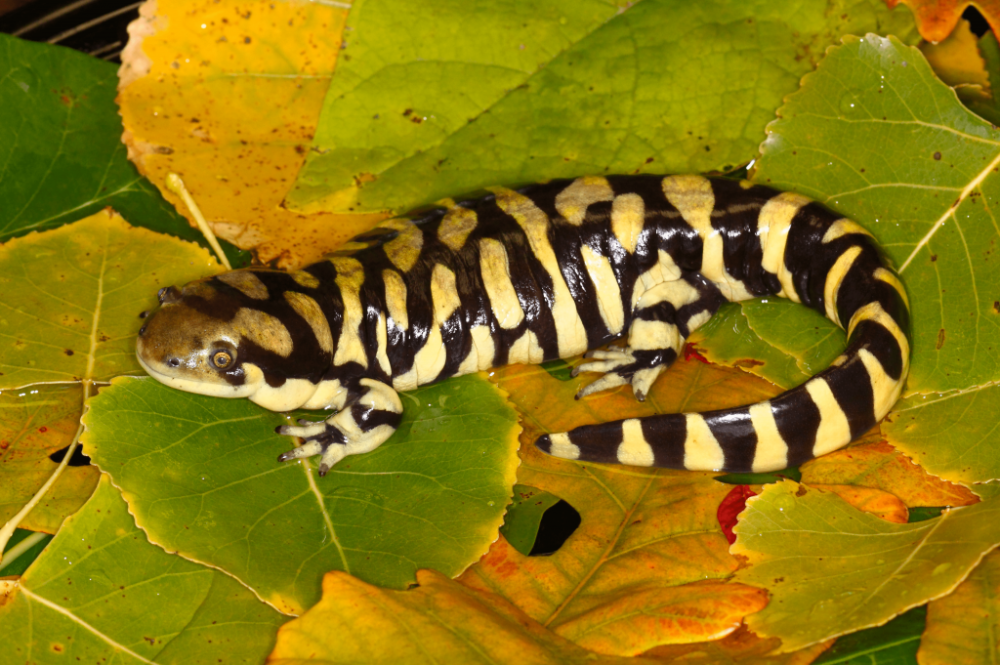Appearance and Adaptations
The Tiger Salamander is a member of the Ambystomatidae family, renowned for its striking appearance and robust build. Adults typically range from 6 to 13 inches in length, although some individuals can grow even larger. Their bodies are characterized by a dark base color, often ranging from olive-green to black, adorned with vibrant yellow or cream-colored stripes that extend from head to tail, resembling the patterns of a tiger.
One of the salamander’s most remarkable features is its ability to regenerate lost limbs—a trait shared by many amphibians. This remarkable capability allows them to recover from injuries and evade predators effectively. Additionally, their moist skin serves multiple purposes, facilitating respiration and serving as a vital sensory organ.

Habitat and Distribution
Tiger Salamanders are habitat generalists, inhabiting a diverse range of ecosystems across North America, including grasslands, forests, marshes, and even semi-arid regions. Their adaptability enables them to thrive in various environments, from humid woodlands to arid scrublands, although they prefer areas with abundant moisture and suitable breeding grounds.
While their distribution spans much of North America, from southern Canada to Mexico, they are particularly prevalent in the central United States, where they are often found in abundance. Their ability to withstand a wide range of environmental conditions has contributed to their widespread presence and ecological success.
Life Cycle and Reproduction
Like many amphibians, Tiger Salamanders undergo a fascinating life cycle characterized by metamorphosis. Breeding typically occurs in early spring when the weather becomes milder and conducive to reproduction. During this time, adults migrate to breeding sites, such as ponds, marshes, or temporary pools, where they engage in elaborate courtship rituals.
Females deposit clusters of eggs in the water, which are then fertilized externally by the male. The eggs hatch into larvae, which undergo a series of developmental stages before transforming into terrestrial juveniles—a process that can take several months to complete. Once fully developed, the juveniles venture into the surrounding habitat, where they will spend the majority of their adult lives.
Ecological Role and Conservation Status
Tiger Salamanders play a crucial role in maintaining the ecological balance of their respective habitats. As voracious predators, they help regulate insect populations, including mosquitoes and other pests, thus indirectly benefiting ecosystems and human communities alike. Furthermore, they serve as indicators of environmental health, with their presence or absence often reflecting the overall condition of their habitats.
Despite their resilience and adaptability, Tiger Salamanders face numerous threats to their survival, primarily due to habitat loss, pollution, and the spread of invasive species. Human activities, such as urbanization, agriculture, and deforestation, have significantly impacted their native habitats, diminishing their available breeding sites and disrupting migration routes.
Conservation efforts aimed at preserving and restoring critical habitats are essential for safeguarding the long-term viability of Tiger Salamander populations. Initiatives such as habitat restoration, pollution mitigation, and captive breeding programs are vital components of these conservation strategies. Additionally, raising public awareness about the importance of amphibians and their habitats can foster greater appreciation and support for their conservation.
Conclusion
In the intricate tapestry of North America’s ecosystems, the Tiger Salamander stands as a resilient and enigmatic ambassador of the amphibian world. With its captivating appearance, fascinating life cycle, and ecological significance, this remarkable creature embodies the delicate balance of nature and the interconnectedness of all living organisms.
As custodians of the planet, it is our responsibility to protect and preserve the habitats that sustain the diverse array of life, including the Tiger Salamander. By embracing sustainable practices, advocating for conservation measures, and fostering a deeper understanding of amphibians and their ecosystems, we can ensure a brighter future for these magnificent creatures and the natural world as a whole.









